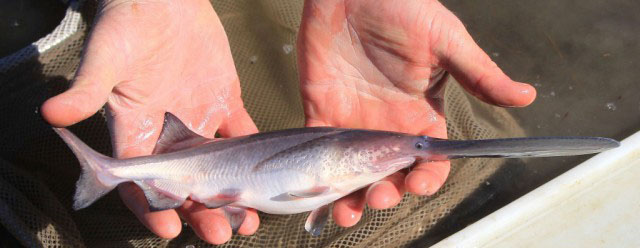
By Julie Geiser
This past week the Nebraska Game and Parks Commission stocked 990 paddlefish at Gallagher Canyon and Midway Canyon Reservoirs located south of Cozad.
The twelve-inch paddlefish have been stocked in efforts to offer anglers a chance in central Nebraska to be able to snag or use bow and arrow on mature paddlefish.
“We hope to establish a sufficient population so that a season can be implemented similar to that on the Missouri river,” said Dave Tunink, Assistant Administrator Fisheries Management Section. Tunink commented that “It will take a high density population to establish a season, which we hope to do in the canal system.”
For now the population will grow primarily from stocked fish – it takes many years for paddlefish to be able to reproduce. While the canal will be a good place for paddlefish to thrive, it is unknown whether they will be able to reproduce there.
More stockings will be done in coming years with paddlefish fry from Gavins Point National Fish Hatchery in Yankton, SD. The fish will be raised at the Calamus and North Platte hatcheries until they are large enough to survive predator fish.

According to Tunink the canal systems should be a good place to establish populations of paddlefish as the water levels are good with deep, open water in the canyon reservoirs and connecting canal system. “The habitat is there for them, as the fish grow people may start to see them surfacing and rolling to feed,” Tunink stated.
Paddlefish have adaptations specifically for filter feeding. Their rostrum and cranium are covered with tens of thousands of sensory receptors for locating zooplankton, which is their primary food source. Paddlefish are constant swimmers and will also collect tiny crustaceans and insects.
Paddlefish (Polyodon spathula) in the order Acipenseriformes (sturgeons and paddlefishes) are one of the most prehistoric and unique fresh-water fish around today with fossil records dating back to the Late Cretaceous period, seventy to seventy-five million years ago.
Primitive characteristics of the paddlefish include a skeleton composed of mainly cartilage and a deep forked, elongated tail fin – the upper lobe being longer than the lower lobe, similar to sharks and finally they are equipped with an elongated, paddle-like snout called a rostrum.
It will take several years to establish a paddlefish population in the canal system, which will hopefully then lead to a season on this unique fish.
